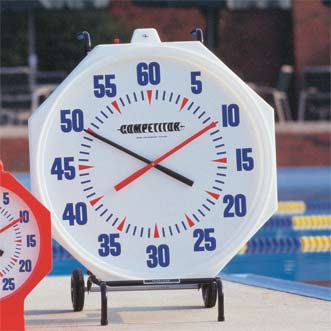Do you need a swim watch when you have a pace clock?
If you like gadgets and/or swim toys you may have found yourself, at some point over the past couple of months, eyeing the new Swimsense Performance Monitor. And after playing with one for a few weeks now, I’ll admit, it’s pretty cool.
Before you fork over $200, though, consider the question: What does the Swimsense - and swim watches in general - offer that a simple pace clock doesn’t?
At this point (early 2011), the features offered by swim watches basically boil down to:
- keeping time
- counting laps
- counting strokes

Obviously, a pace clock is great at keeping time. Did you know it can also count laps? Assuming you keep a roughly steady pace, you can almost always use the pace clock to verify the lap count on a long swim. During my 10K Postal swim last fall, I had a direct view of a large digital pace clock at the end of each 100m lap. Whenever I pushed off the wall to begin a new lap, I glanced at the clock on my first breath. This helped me keep a perfect lap count for 10,000m, without having to consult my human counter. And, since I looked at the clock at the same point every lap (~5m off the wall), I also got my 100m splits to an accuracy of less than 1 second.
What about counting strokes? OK, pace clocks can’t count strokes. But really, is it that difficult to count your own strokes? (Especially in a short course pool.)
The Swimsense has some interesting additional features - the ability to upload workout data to your PC, for example - but that’s more about the “platform” than the watch itself. It still just keeps time, counts laps, and counts strokes. No integrated heart-rate monitor or anything (yet).
Pace clocks even have a few advantages over swim watches:
- you don’t have to strap them to your wrist
- you don’t have to carry them in your bag or worry about losing them
- you don’t have to fumble with any buttons to activate them as you’re pushing off the wall
So actually, pace clocks are pretty awesome. Indeed, a swim watch would have to be quite a bit more awesome - $200 more awesome, in fact - to justify the purchase. Does the Swimsense clear the bar? Stay tuned. For now, I’ll list a few situations that might alter the calculus slightly toward investing in a swim watch:
- your pool doesn’t have a pace clock
- your pool has a pace clock, but you can’t see it from your lane
- you swim primarily long course, so counting your own strokes is somewhat more mentally cumbersome
- you’re training for a marathon swim and do regular long steady-state swims where you just want to zone out and not worry about counting laps
On that last point - unless you’re training for a marathon swim, there’s really no reason to be doing lots of steady-state swimming (unless you enjoy it). Interval training is far more effective, and a lot more fun!